international economy 1700 to 1800

Figure 1. The triangular route taken by slave ships from European ports such as Liverpool, Bristol, and Bordeaux took them to Africa to collect slaves, across the Atlantic to sell them and back again with cargoes bartered in exchange. The major share of the slave traffic was carried on by Great Britain by the end of the 18th century, supplying plantations in the West Indies and in the Americas.
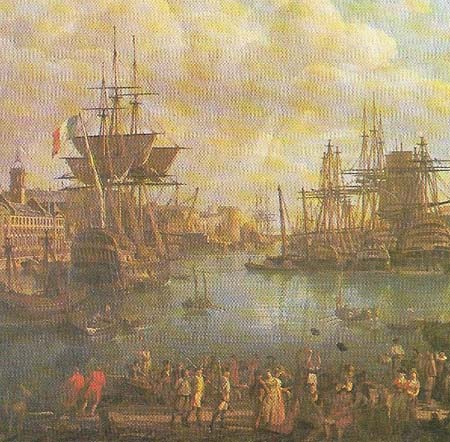
Figure 2. Brest, on the Atlantic coast of France, and other Atlantic ports such as Bristol, Bordeaux, and Liverpool, grew enormously rich on the profits of the slave trade and colonial traffic.
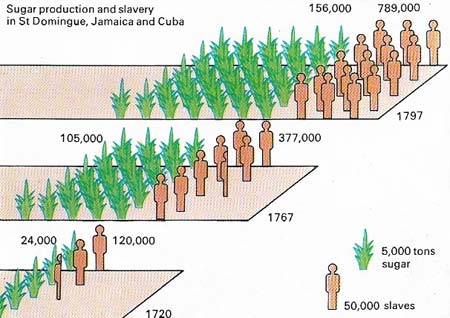
Figure 3. Economic development in the West Indies depended on a steady supply of slave labor from Africa. The slave population and sugar production grew to satisfy the European demand for sugar.

Figure 4. Trading horizons widened in the 18th century as European contact with hitherto exotic countries became more regular. Tea plantations in China were developed to meet a taste for tea in Britain and an extensive trade also grew up in silk, porcelain, and spices. Although China limited European influence to specified trading centers, these provided a foothold that was extended in the next century.
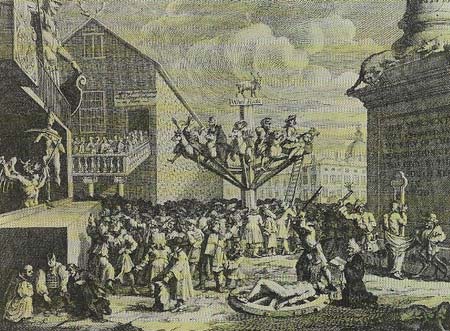
Figure 5. Speculation, greed, and dishonesty were caricatured by the satirist William Hogarth (1697–1764) in 1720 when the South Sea Company, upon which heavy speculation had centered, collapsed, and led to a change of government. Financial and credit institutions in the 18th century were often unstable, partly because governments were apt to draw on them for credit and also because investors panicked easily.

Figure 6. The Hudson's Bay Company,whose Fort Garry, Manitoba, trading post is shown here, was founded by the British in 1670 to open up a lucrative trade in Canada, supplying Europe with furs, timber, and salted fish. Simultaneously, the colonists at Albany and New York were extending trade with Indians. France was also active in the Canadian trade but lost its share in 1763 when it was defeated in the Seven Years War and thereafter surrendered control of Canada to Britain.
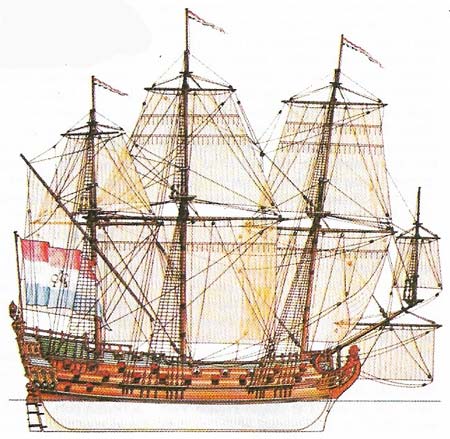
Figure 7. Wordlwide expansion of Europe's trade in the 18th century was carried in ships such as this heavily armed East Indiaman.
During the eighteenth century trading links between Europe and the rest of the world strengthened into commercial bonds that were vital to the prosperity of several European states and to many of their merchants and workmen. The rise of Great Britain to a dominant position in trade, overtaking the Dutch, Spanish, and French, showed itself in extensive contacts and trading arrangements with the Americas and Asia (Figure 4). There was a general expansion of trade at the same time, particularly in the Atlantic, in which other countries, especially France, shared. Expansion of trade brought with it specialization in shipping and financial business and provided a stimulus to the increased production of manufactured goods in Europe.
Incentives for trade expansion
The expansion of European influence in the years before 1700 had introduced a wide range of precious and tropical products which were the staples of extra-European trade. Gold and silver bullion had provided one major component of the trade of the declining Spanish Empire, but this trade had also included spices, tobacco, coffee, sugar, and cocoa. A growing taste in Europe for tropical products gave merchants the incentive to incur the risks of long overseas voyages. Merchants from countries such as Britain and France, which were relative latecomers to colonial trade, made greater efforts in the 1700s to capture part of the trade controlled by the older empires.
Several commercial wars were fought by the other European nations to open up the colonial trade of the declining Spanish Empire to their merchants. In 1715 British merchants obtained permission in the Asiento Treaty to deliver 4,800 slaves annually to the Spanish colonies and forme ship a year to trade with Panama. In all other respects, Spain tried to keep her colonial trade closed. But because Spain was unable to supply all the needs of her colonists, there was much illicit traffic, especially in slaves and in manufactured goods. After the Seven Years War (1756–1763) this rigid control was relaxed and Britain and France seized a greater part of the Spanish American trade.
Similarly, British and Dutch ships captured an increasing share of Portuguese trade. In the East, the Dutch had taken over much of the old Portuguese Empire. With stations in Ceylon, Bengal, Malabar and Batavia their influence extended as far as Japan. Organized through the Dutch East India Company based on Batavia in Java, they carried on a lucrative trade in spices, coffee, and silks. By the end of the century, however, they began to feel the effects of competition from the British and French.
French and British power
France had colonies in North America, including Quebec and Louisiana, and in the West Indies, including Guadeloupe and Martinique; she held Senegal in Africa and colonized Madagascar and Mauritius in the Indian Ocean. In India, France maintained important trading positions at Pondicherry and Chandernagore. From these colonies and contacts French trade grew rapidly in the late 18th century, especially with the West Indies. After the Seven Years War, however, France lost Quebec and much of her influence in India. Nonetheless her busy trade with the remainder of her colonies led to the expansion of ports such as Bordeaux, Nantes, and Brest (Figure 2); Marseilles prospered with the Levant trade.
The major rising power was Great Britain, which exerted its superiority over the older empires by the middle of the century and conducted all the trade of its colonies in British-registered ships. In spite of the loss of the North American colonies, trade continued to expand with the Americas both through chartered companies, such as the Hudson's Bay Company (Figure 6), and through more open commerce. The vastly profitable but inhuman slave traffic was primarily in British hands by the end of the century, the "Triangular Route" (Figure 1) between Britain, Africa, and the Americas providing great profits upon which mercantile cities such as London, Liverpool and Bristol flourished. Second only to the slave traffic in importance was the sugar trade (Figure 3), which provided, with other tropical produce, a valuable re-export trade to continental Europe. In the Indian Ocean the British East India Company triumphed over the French and controlled Bombay, Bengal, Madras and most of southern India; but by the end of the century the trade was opened up and the company's monopoly broken.
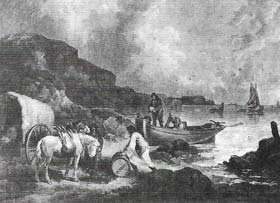 |
| Smuggling in the 18th century was a common way of avoiding heavy duties on commodities such as spirits, wines, and tobacco. Revenue men waged an intermittent war with smugglers in many parts of Europe, especially in remoter areas. |
Stimulus for industrialization
Expansion of trade led to increases in merchant shipping and the development of more versatile credit and financial institutions. In London, firms of shipping insurers, such as Lloyd's, began to supplant the Dutch. Growing trade led to relaxation of the old mercantile ideas of monopolistic companies and favored the adoption of laissez-faire ideas of free trade and open competition.
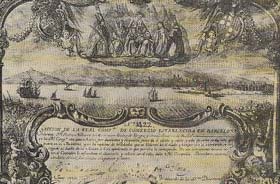 |
| Spanish financial institutions, established in the 16th century, shared in the great expansion of European trade in the 18th century.This deposit certificate, dated 1759, is from the Real Compania de Comercio of Barcelona. |
In many countries industries grew up that refined tropical products and re-exported them either to other European countries or back to the colonies as manufactured goods. Thus sugar-refining, tanning, distilling, and many other processes became early examples of industrial activity. The most striking development by the late eighteenth century was the rapid rise in raw cotton exports from the southern states of America to the growing British textile industry.
